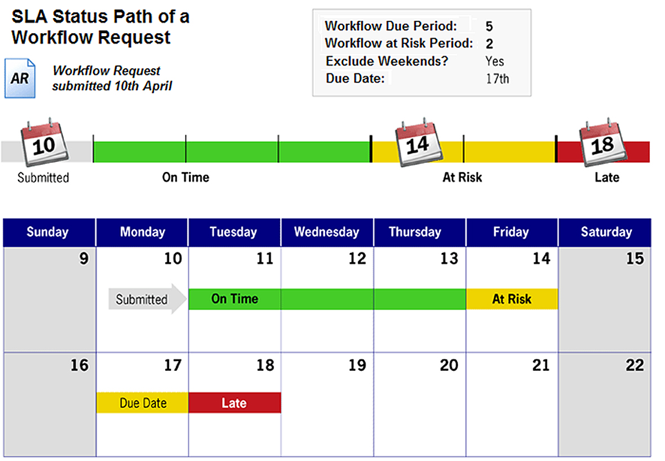
Workflow Manager 5.6
SLA (Service Level Agreement) time tracking is used to report the status of a workflow request with respect to its SLA due date, as one of: On Time, At Risk, Late, Completed on Time, or Completed Late.
Project SLA Settings and the Workflow Request Due Date
Each time a project is created, the following SLA settings are defined:
| • | Workflow Due Period—Number of days after its submission date that a workflow request should be completed, in order to be SLA compliant. |
| • | Workflow at Risk Period—Number of days prior to a workflow request’s due date that the workflow request will be considered “at risk” of not meeting that date, if it not yet completed (corresponds to SLA status At Risk). |
| • | Length of a Work Day—Number of hours in a day that are considered work hours, when monitoring elapsed time for SLA calculations. |
| • | Exclude Weekends—Specifies whether to exclude weekend days when calculating a workflow request’s SLA status. |
| • | Holiday Information—Identifies the holidays to exclude from SLA calculations. |
A workflow request’s due date is automatically calculated by adding the number of business days in the Workflow Due Period field to the date that the request was submitted.
Note: The Workflow Due Period and Workflow at Risk Period values specified for a project can be overridden at the workflow request level on the Properties tab of the Workflow Progress page. See Properties Tab for more information. Also refer to Project Details Page for more information about defining the SLA settings.
Example of a Workflow Request’s SLA Status Path
The following diagram illustrates the SLA status path of a workflow request with a Workflow Due Period of 5 days and a Workflow at Risk Period of 2 days, with weekends excluded from the calculations:

Example SLA Status Path for a Workflow Request
See Also
Stopping and Restarting the SLA Clock
Tracking a Workflow Request’s SLA Status
Workflow Manager 5.6 / AdminStudio Enterprise Server 11.0 Help LibraryDecember 20, 2011 |
Copyright Information | Contact Us |